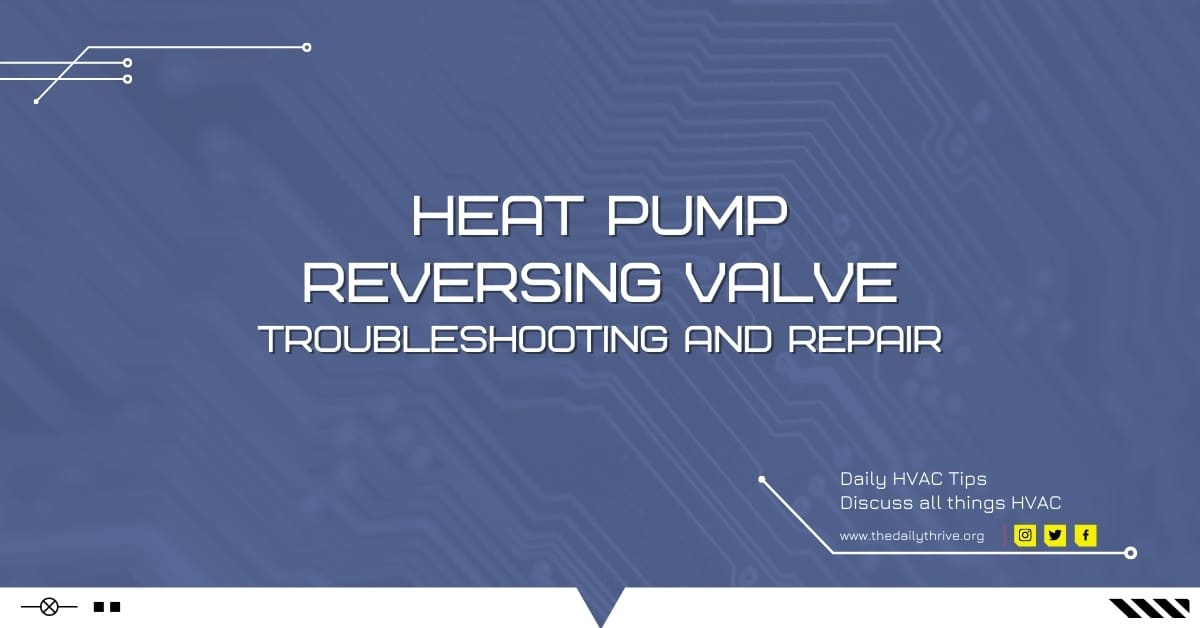The component that allows heat pumps to provide both heating and cooling is called the reversing valve. This valve allows the unit to change the direction of the refrigerant flow, which is how the system can change modes between heating and cooling. Sometimes problems can develop with the heat pump reversing valve, resulting in the valve getting stuck or frozen in a specific mode.
Here are the necessary steps to troubleshooting a heat pump reversing valve malfunction.
What is Heat Pump Reversing Valve
The reversing valve is a four-way valve that connects tubes corresponding to the compressor discharge line, return line, indoor coil, and outdoor coil. There is also an attached solenoid responsible for channeling refrigerant to one coil or the other. Inside the actual valve is a slide that is pushed to divert refrigerant or gas by the solenoid.
Heat pump reversing valve is what makes the system responsible for both heating and cooling functions.
Heat pumps system are connected to dual-use thermostats that allow homeowners to simply press a button that changes the mode. When the button is pressed, the solenoid pushes a sliding mechanism in the valve in the direction opposite from its current location. As the sliding mechanism moves in the opposite direction, the flowing refrigerant helps push the mechanism the rest of the way.
How Does it Work?
When in heating mode, the solenoid moves the slide to block refrigerant flow from the discharge port to the outdoor coil. This causes the warm discharge from the heat pump to flow to your indoor coil instead, circulating warm air into your house.
Meanwhile, the cool airflow from the outdoor coil is directed back into the heat pump to be warmed and discharged back to the reversing valve, where the process repeats.
In cooling mode, the entire process is reversed. The warm air from the discharge port is shunted off to the outdoor coil, where it is cooled by the compressor and passed to the indoor coil to be circulated.
The entire process works because of this one small part. Without it, the heat pump would not be able to switch modes. Because of the complicated and vital nature of this part, we recommend that you call a professional HVAC technician if you suspect that the heat pump reversing valve is not functioning correctly.
Problems That Can Develop with a Reversing Valve
When a reversing valve gets stuck or frozen in a particular mode, there can be a few reasons for this occurrence:
- Bad Solenoid
The solenoid is necessary to help move the sliding mechanism; sometimes, the wiring around the solenoid can corrode, or the solenoid itself breaks down. The good news is that bad solenoids can be replaced. - Refrigerant Leak Inside the Valve
Refrigerant leaks can develop anywhere in your heat pump system, and this includes the reversing valve. Unfortunately, there is no way to repair a refrigerant leak inside a reversing valve. The heat pump reversing valve will need to be replaced. - Poor Installation
If the reversing valve was not installed correctly, it could cause the valve to stuck.
Heat Pump Reversing Valve Replacement
The heat pump reversing valve that is stuck doesn’t mean that the valve is faulty. Often this failure may be caused by some other problem. Be sure to find out what makes the valve malfunction before replacing it.
The average cost of replacing a heat pump reversing valve is $250 to $1000.
A reversing valve replacement is probably the most challenging task of heat pump repair. Make sure you have the right guy to handle the replacement process.
Here are some tips on proper procedures for reversing valve change out on a heat pump.
- Be sure you have a replacement reversing valve with the correct capacity for the heat pump system.
- Removing the valve using a tube cutter instead of unsoldering the joints usually means that you will have to fabricate new sections of the refrigerant line. Never use a hacksaw under any conditions to cut tubing.
- Be careful to protect the valve from excessive heat. Temperatures above 250°F are apt to damage internal parts. Wrapping a wet rag around the valve body while using the torch should do the trick.
- Applying too little heat is also a problem. The soldered joints will be challenging to separate. Still, the buildup of heat over the longer time required will transfer to the valve body and possibly damage internal parts.
- When changing the valve, be sure to protect all tubes from an entry of foreign matter, such as moisture, dust, or dirt.
- If you find any leaks, dump the leak check charge, repair the leaks, pressurize the system again, and retest.
- When all leaks have been repaired, triple evacuate the system with a good vacuum pump, charge the system entirely, start it up, and check it out. Cycle the reversing valve a dozen times to ensure it is operating correctly.
The reversing valve is the key to every heat pump’s ability to change modes. If you’ve noticed that your heat pump isn’t changing modes as needed, call the HVAC dealer and schedule an appointment to get your heat pump serviced.






